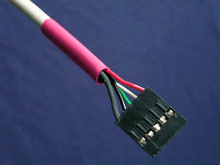Shrink tubing
A shrink tube is a plastic tube that contracts strongly under the influence of heat (usually through the supply of hot air ). It is mostly used to electrically isolate material introduced into the hose before it is heated and to protect it from damage. Shrink tubing was invented in 1962 by the American Raychem Corporation.
properties
Shrink tubes are available with diameters from 1 mm to max. 1100 mm available. Alternative shapes are shrink caps, which are already closed on one side, and shrink dividing caps, which have three or more openings.
The shrinkage range, the shrinkage ratio or the shrinkage rate (i.e. the maximum change in size when shrinking) is heavily dependent on the plastic used. The shrink ratio is 2: 1 to 6: 1, with special connector seals up to 10: 1. To achieve the best possible seal, shrink tubing can be coated on the inside with a hot melt adhesive . Manufacturers recommend a ratio of 4: 5 between the diameter of the object being insulated and the shrink tube for best results.
The plastics used are thermoplastics . In order to shrink the material when heated (to a temperature range typical of the material), the plastics must be crosslinked after production. By networking the molecular chains are connected to each other, which z. B. can be done by silanes or by electron beams. The extrudate treated in this way can now be expanded in the warm state (temperature range approx. Extrusion temperature). By cooling, the material is frozen in relation to the recovery of the last stretch, so to speak, the expanded diameter is retained and thus tensions in the network bridges at the molecular level. When heated again, the shrink tubing can then reorient itself.
Shrink films , which are often used to fix goods or boxes stacked on pallets, can shrink unidirectionally or bidirectionally depending on the manufacturing process, i.e. they only contract lengthways or crossways when heated.
There are also so-called cold shrink tubing. They consist of elastomers such as EPDM or silicone rubber . They are based on a different technology ( rubber elasticity ), so they do not require any heat and can therefore be used for e.g. B. can also be used under water. They are delivered in a stretched state on a support coil that is removed for assembly. There are also rubber grommets (e.g. made of polychloroprene rubber) which, supplied without a helical support, are assembled with the help of three-arbor pliers . However, they are not marketed as cold shrink tubing .
species
With shrink tubing, a distinction is made according to wall thickness, diameter and shrink ratio.
- Shrink ratio (common: 2: 1, 3: 1, 4: 1 and 6: 1)
- thin, medium and thick-walled
- with / without inner adhesive
- Standard diameter (mm): 1.2; 1.6; 2.4; 3.2; 4.8; 6.4; 9.5; 12.7; 16.0; 19.0 (examples)
commitment
- Airtight, watertight and therefore corrosion- proof covering of a connector attached to a cable
- Restoration of damaged cable insulation
- Shrink connection sleeves (insulation and mechanical protection)
- Packing of general cargo
- as a shrink capsule over wine bottles to protect the cork
- Fixation of ferrite rings ( sheath wave filters ) on cables
- In the manufacture of battery packs : The individual cells that have previously been electrically contacted by soldering or welded connections are shrunk together to form a pack.
- Prevention of short circuits
- Protection of cables in the underground area with cable repair sleeves (thick-walled shrink tubing)
- Protection against penetration of moisture (shrink tubing with inner adhesive)
- Padding of the steel frame of the OneDollarGlasses at the contact points ( nose bridge and temple ends)
Selection of plastics used
- Polyolefins
- Polyvinylidene fluoride (PVDF)
- Viton
- Polyvinyl chloride (PVC)
- Polytetrafluoroethylene (PTFE, also known as Teflon)
Web links
Individual evidence
- ↑ U.S. Patent 3,396,460 . US Patent Office, 1968.
- ^ Quality Today . IPC Industrial Press, 1994.
- ↑ Fermilab / SLAC symmetry magazine: accelerator apps: heat-shrink tubing , Vol.07, April 1, 2010.
- ↑ 3M Technical Information Cold Shrink Tubing EPDM. (PDF) 3M Deutschland GmbH, June 2010, archived from the original on August 12, 2016 ; accessed on August 11, 2016 .
- ↑ 3M technical information cold shrink tubing silicone. (PDF) 3M Deutschland GmbH, June 2010, archived from the original on August 12, 2016 ; accessed on August 11, 2016 .
- ↑ Heat shrink tubing Cold shrink tubing. In: Shrink Products - Cable Accessories. ELTA GmbH , accessed on August 11, 2016 .



